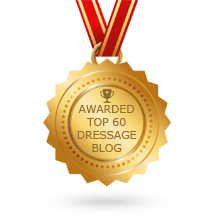|
In dressage, your position is critical to being able to move with your horse, which in turn is important for feeling the communication that your horse gives you and this allows you to give precise, well-timed aids without interfering with your horse. A good position creates a balanced rider, necessary for riding in harmony. An important aspect of the rider’s seat is balance. As soon as the rider’s balance is lost, the horse also becomes unbalanced and heavy in the forehand, leaning on the rider’s hand. A good position allows the rider to maintain balance in movement with the horse, whereas an unbalanced rider impedes the horse’s natural movement. There is a lot of information about the correct position, and whilst the basic principles of posture for the dressage seat remain the same, it is important to apply them in relation to each rider. The position of a tall rider will not necessarily look the same as the position of a shorter rider, especially on different shaped horses. A common phrase used for dressage riders’ position is a deep seat, which refers to the ability of the rider to move their pelvis and lower back in complete harmony with the horse’s back movement. This seat is developed by having your leg stretched out from the hip, around the horse’s rib cage without gripping, and your upper body balanced over their seat bones, without wobbling from side to side or backwards and forwards. In this position, your spine can move precisely with the movement of the horse’s spine. Once the rider loses balance, they often resort to gripping with the legs or pulling on the reins to regain their balance, or just to stay with their horse! When this happens, the horse is instantly blocked, and the rider’s aids are indistinguishable from the gripping or pulling. As the horse tries to compensate for the rider’s lack of balance, they too become unbalanced. The strength of the rider’s position or seat comes from being able to maintain balance. Toned core muscles are needed for this, muscles that can react quickly by an appropriate amount and then instantly release. Full on muscles are not always needed, sometimes the slightest movement is sufficient to rebalance the horse. When the rider finds that state of perfect balance, the horse begins to move more freely and then they can start to develop their suppleness. The rider can feel the responses the horse gives and adapt the exercises accordingly. ©Training Riders, Transforming Horses
|
AuthorDiane Followell Classical Dressage Trainer 
|
Telephone+44 (0)7931551014
|
|
© Diane Followell 2015 -2024.
All Rights Reserved.
All images and content are copyright Diane Followell unless otherwise stated.
All Rights Reserved.
All images and content are copyright Diane Followell unless otherwise stated.



 RSS Feed
RSS Feed

